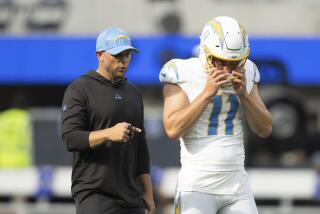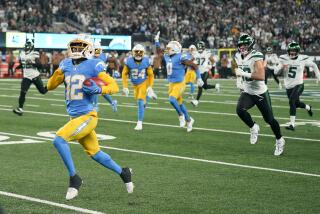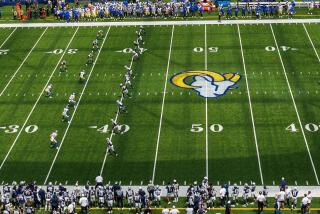Pass Defense May Be Thing of Past in NFL
It’s time to wave the white penalty flag in the NFL’s 10-year bout against competent pass defense.
When league rulesmakers decided to open up the air game in 1977 by permitting defenders only one bump against eligible receivers, they created elementary problems in the secondary.
Unsatisfied with that step, the NFL hurled another bomb past frazzled cornerbacks the next year by penalizing defender-receiver contact beyond five yards of the line of scrimmage. Offensive linemen were also allowed to extend their arms in giving quarterbacks more time to throw.
“They put all the rules against the defense every year it seems,” says Atlanta defensive back Scott Case. “It seems like the league is determined to make the game more exciting, and that usually means more points. Also, quarterbacks are great athletes today and when you have to cover a receiver all over the field . . . well, there’s just no way. You’ve got to get the pressure up front and get the passer shaken a little--that’s when turnovers come.”
Three yards and a cloud of dust have evolved into 18-yard passes and turf toe. If you can’t complete passes at a 55% clip these days, you’re scanning the waiver wires daily to make sure you’re not a line of agate in the transactions section. One reason the Bears’ pass defense appeared so stingy in ’85 (47.7% completion rate) was the relatively poor defense by other NFL clubs.
The Tampa Bay Buccaneers allowed a 63% completion rate and two starters from the defensive backfield--safety David Greenwood and cornerback John Holt--have already been waived and replaced by rookies. That’s only part of the solution, though; without the benefit of a steady pass rush, even a Mike Haynes will be repeatedly beaten by an accomplished receiver.
“Chicago’s defensive success stems from the pass rush,” says Tampa Bay’s Steve DeBerg, who drilled the Bears for 506 yards and five touchdown passes in two games last season. “Their philosophy is to put a tremendous amount of pressure on the quarterback and play aggressively against the receivers. I can remember two times last year when they didn’t cover my tight end on a corner route--nobody within 20 yards of the guy--but I couldn’t plant my feet (and throw) against their all-out blitz.”
DeBerg says the recent rules which define pass interference more narrowly could represent a trend.
“What the rules have done the last few years is give the defensive backs more leniency in going for the ball,” DeBerg says. “There was such an advantage for the offense that average receivers were beating outstanding defensive backs. The big change was the 5-yard bump rule and allowing linemen to use their hands to block.
“Everyone is trying to emulate the Bears’ defense right now, but the difference is in Chicago’s personnel. They get good pressure right up the middle, where a quarterback doesn’t want it, but the weakness of that defense is defending against the tight end spot. We’ve got an All-Pro in Jimmie Giles and he’s one-on-one with a linebacker.”
Passing schemes are so complex and refined in the 1980s that the risk has virtually been squeezed out of the wide-open attack. Unless protection breaks down, three out of every five passes will find the mark. Defensive coordinators all over the league are reeling through the years watching films of Mike Singletary and the rest of the radical Chicago 11.
“Against the teams with strong passing games, we blitzed everybody and played man-to-man all over the field,” says Wayne Fontes, defensive coordinator for the Detroit Lions. “We also used different alignments to confuse them and give them a second of doubt.”
According to Atlanta defensive coordinator Marion Campbell, the rules of the game aren’t the real culprits in pro football’s lopsided air war.
“They put in those rules to cut down on sacks,” Campbell says, “but it’s still a people game. You’ve got to have the great rush--it all starts there--and I find today’s game more of a challenge defensively. It’s stimulating to try and create situations that are to your team’s advantage. It’s still possible to play effective pass defense: you just have to work harder at it, that’s all.”
More to Read
Go beyond the scoreboard
Get the latest on L.A.'s teams in the daily Sports Report newsletter.
You may occasionally receive promotional content from the Los Angeles Times.










